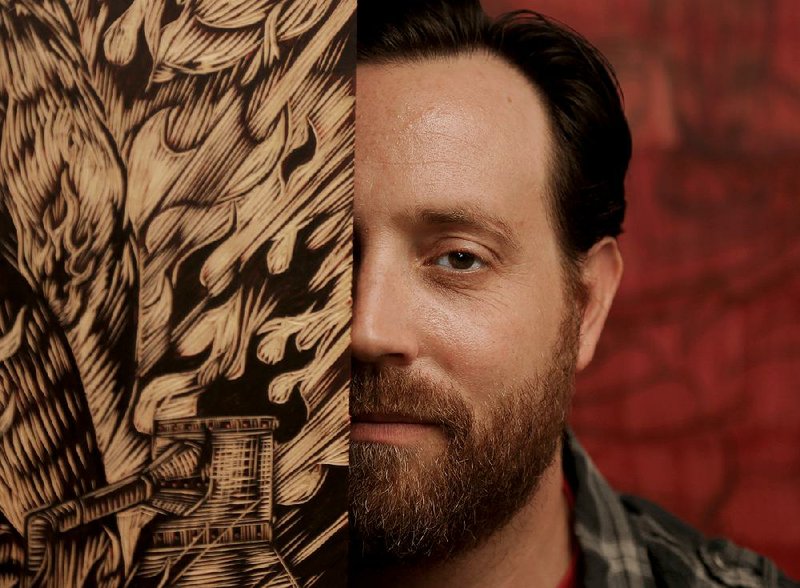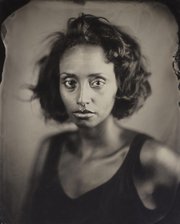RUSSELLVILLE - Academics brought a pair of artists to this Arkansas River Valley community whose works won consecutive Delta Awards from the Arkansas Arts Center.
Last year it was Helen, whose big eyes and a guarded expression confront the viewer while the rest of her blurred gradually into a background as insubstantial as smoke.
This year it was the frenetic energy of Snake Shaker’s Shack, summoning the frenzy of a juke joint and the religious fervor of serpent-handling from what was once a humble building material.
Each was a winner at the Arts Center’s prestigious Delta Exhibition, and each was produced by an artist living in Russellville - printmaker Neal Harrington, whose large scale works are carved from inexpensive grades of plywood, and photographer Keliy Anderson-Staley, whose large-format photographs are created through a process that hearkens back to the mid-1800s. Both admit that, when it comes to their chosen media, they’re doing things the hard way. And that’s how they like it.
“That’s the challenge for me,” Anderson-Staley said of using the wet plate collodion process to create images on sheets of metal instead of film. “If it was easy, it wouldn’t have held my attention so long. I’m a martyr for process.”
“I love it when something happens that I totally hate,” Harrington said. “Like when I’m carving and something skips across and I have to incorporate it. As soon as it loosens up, I lighten up and like it much better.”
How they wound up in Russellville, which isn’t usually thought of as a hot spot for artists, can be summed up in three words: Arkansas Tech University.
PLYWOOD PRINTER
A native of South Dakota, Harrington was a painter when he received his bachelor of fine arts degree from the University of South Dakota; that’s also where he met his wife, Tammy, who was studying printmaking. They attended graduate school at Wichita State University in Kansas, but partway into his studies Harrington realized he’d rather be making prints. He switched disciplines and, after the couple both graduated in 2001, he accepted a one year visiting professorship at Tech. He became a full-time professor in 2006; his wife was hired as “an art department of one” at University of the Ozarks in Clarksville.
He’d submitted his work to the Delta Exhibition every year, but without success. But this year, he had not only his Delta Award-winning piece in the show, but also two epic-scale prints based on the ancient myths of Daphne and Europa.
“They’re 89 by 48 inches,” he said. “I know exactly because the piece of wood fits in my basement exactly, from floor to ceiling.”
Harrington carves images by hand into plywood (or other woods, or materials such as vinyl), hand-inks the plates and presses the paper onto it to create the image. Depending on the size of the plate, he can use a press at the university, but his largest ones don’t fit. So he came up with an alternative.
Meet The Big One: A 4-foot-wide roller made from a cylindrical construction form filled with seven 60-pound bags of cement. It has a pipe through the middle so he can shift it back and forth. It weighs more than 400 pounds, which explains why there’s a weight-lifter’s bench just outside the basement studio in his home.
He lays the woodcut on a tarp on the floor, inks it, places paper on it, then makes a pass with The Big One.
“No, I would say, on average at least 12,” he said. “It’s a lot of work to print one but, well, it’s worth it.”
There’s a catch: The woodcuts don’t print with perfect regularity. After making several passes, he eases the roller off and, having weighed down one end of the 7-footplus sheet of paper, carefully peels it back.
“I lift it up carefully, because if it shifts, it’s over,” Harrington said. “I’ll see that it’s a little light here, so I drape the paper over and totally expose it, apply more ink where it’s light, roll it back down, hoping it lines up, and bring this [roller] back over a couple more passes in different directions. It’s a whole dance.”
No wonder his prints are very limited editions - usually 10 or fewer.
Harrington draws upon a wide range of inspirations. His large prints in this year’s Delta drew upon Greek myth - the story of Daphne, who was turned into a laurel tree in order to escape the romantic attentions of the god Apollo; and the story of Europa, a Phoenician woman carried off by Zeus after he took the form of a bull.
“The main thing people tell me when they see my work is they’ll be complementary, but then they’ll say, ‘I don’t know where I’d put it in my house,’” he said. “I say, ‘Over the couch is nice.’ Some of the work, yeah, is a little risque, but that’s part of society. I guess I don’t worry about it too much and I still make it, but at the same time I’d like to sell stuff.”
In addition to his own work and teaching at Tech,Harrington says, he’s immensely fortunate that the university agreed to open an art gallery on campus, which he manages. It gives him a place to display the work of his students and area artists. That’s where he met Anderson-Staley, then a new arrival in Russellville with a lot of photographs to show and in need of a place to show them.
PLATES AND POISONS
A Maine native who lived in New York for 10 years, Anderson-Staley came to Russellville three years ago when her husband, Matt Williams, took a position as assistant professor of English at Tech.She has also taught photography part time there. Finding fellow artists - she met Harrington within a couple of weeks after arriving - and the broader arts community in the region wasn’t a problem, she said.
“Because I grew up in a very rural part of America, it wasn’t a culture shock - it was much more of a small town place than Russellville,” said Anderson-Staley,who recently accepted a position as assistant professor of photography at the University of Houston. “I think I was lucky in I was already adept at knowing how to find a community, and I was lucky enough to reach out to the photo departments at the University of Central Arkansas, the University of Arkansas at Fayetteville and Hendrix College. I was able to do demonstrations for their students and give lectures and have a show of some sort, as well as at Tech and University of the Ozarks.
“New York City taught me that making artwork is, like, 25 percent of your time and getting it out to the world and doing PR and trying to get it seen is 75 percent of your time, I was lucky enough to be bold enough to contact people and ask them,” she said. “And I was really lucky to be part of the Delta show,which led to other things.”
She also found an advantage in being an artist who lives outside the Little Rock area, away from the perceived center of the state’s arts scene.
“In a metro area with lots of galleries and museums and artists, you’re so social that you don’t necessarily have enough time to make your work,” she said. “Living here was very ideal, working on new projects and having time I never had in New York City.”
That’s a good thing because her photographs are extremely time- and labor-intensive. She often works with huge cameras, like the vintage Deardorff camera with a 1901 Unar lens that sits on a heavy wooden stand in her studio. It creates plates that are 8 inches by 10 inches. There is a modern 11-by-14 Star Camera Co. model in her house and she has worked with ones that make even larger images.
The wet plate collodion process is largely the same as was used for tintypes in the mid-1800s. Instead of using film, she creates her images on sheets of metal - aluminum, in her case - which she treats with a variety of chemicals, some highly toxic.
The first of those is the collodion, which is cotton liquefied with nitric acid, followed by cadmium bromide and potassium iodide, both salts. Then the plate is sunk in a tank of silver nitrate, which reacts with the salts to make the plate photosensitive.
The prepared plate goes into the camera and when her subject is ready, she removes the lens cap to make the exposure. Once that’s done, more chemicals are used to develop the image: ferrous sulfate (iron combined with acetic acid) for the developer, followed by water to stop the developing process. Potassium cyanide is the fixative, which makes the image permanent.
Did we mention she’s pouring these chemicals while holding the exposed metal plate in her hand?
“Ideally, a vent hood would be great,” Anderson-Staley says. “In the garage, I’ll open the windows and doors and have a fan blowing out. And yes, I use a good chemical respirator, so I don’t smell any of it or breathe in any of the powder.”
It’s in the powder form that the potassium cyanide is particularly dangerous, she said, but there’s only a tiny volume of it involved.
“For a fixer bath you use 4 grams of potassium cyanide,” she said. “Once in liquid form, it is much more benign.”
Still, she plays it safe. In addition to working in a filter mask and in a well-ventilated space, she has had her liver and kidneys tested for cadmium bromide levels “and they’re all fine.” If she’s working in an enclosed space or where there are lots of kids around, like at a museum demonstration, she’ll use a different fixative.
The images Anderson-Staley creates through this process are possessed of power and subtlety. Helen is a perfect exemplar. The field of focus is tight: her eyes, her nose, her mouth. From there, it gradually phases out of focus toward an indistinct gray background that focuses the viewer on those remarkable eyes. Anderson-Staley took several photos of Helen -that was her actual name - over the course of the session, trying to find the one that would capture the underlying elements that made her who she was: a part-Norwegian, part-Ethiopian woman living in America. It appeals, Anderson-Staley says, to her sense of anthropology and ethnographic studies.
So, does that mean she’s an anthropologist? “No!” Anderson-Staley laughs.
“Maybe I would’ve been,” she says after a moment’s reflection. “I’m the anthropologist [who] doesn’t want to do any research. I’ll just present my subject and let the audience guess.”
ART BEGETS ART
As for Russellville not necessarily being an art Mecca, Harrington and Anderson-Staley say an art community exists wherever you make it, and doesn’t acknowledge city limits or county lines. But being neara college does tend to help.
“I think it is in development and God bless ’em,” Harrington said of the arts in Russellville.
“They’re all very interested in the arts,” he said of the university and surrounding community. “It’s definitely a burgeoning area.” Neal Harrington’s art hangs at Cantrell Gallery in Little Rock.
Style, Pages 47 on 07/21/2013


